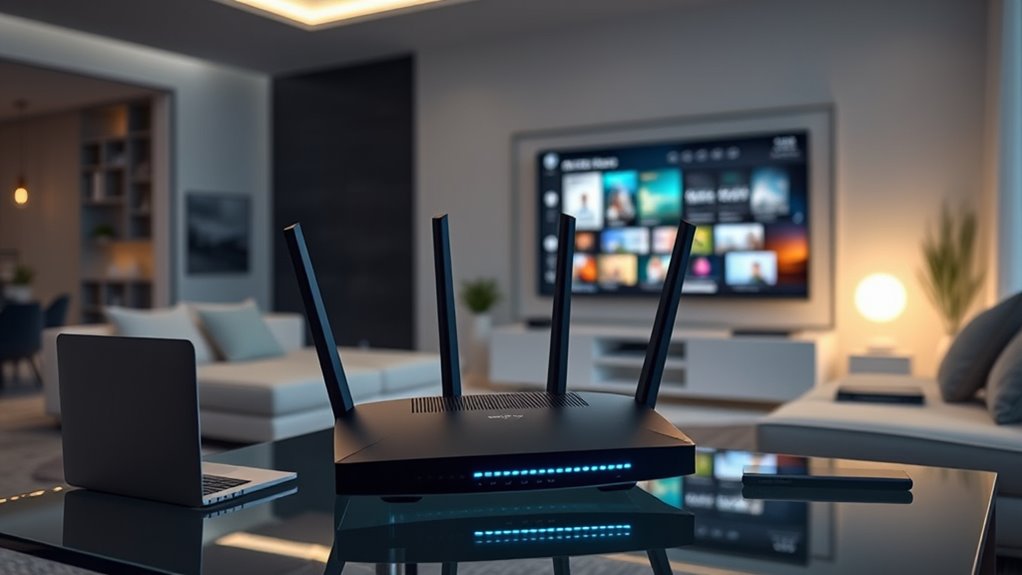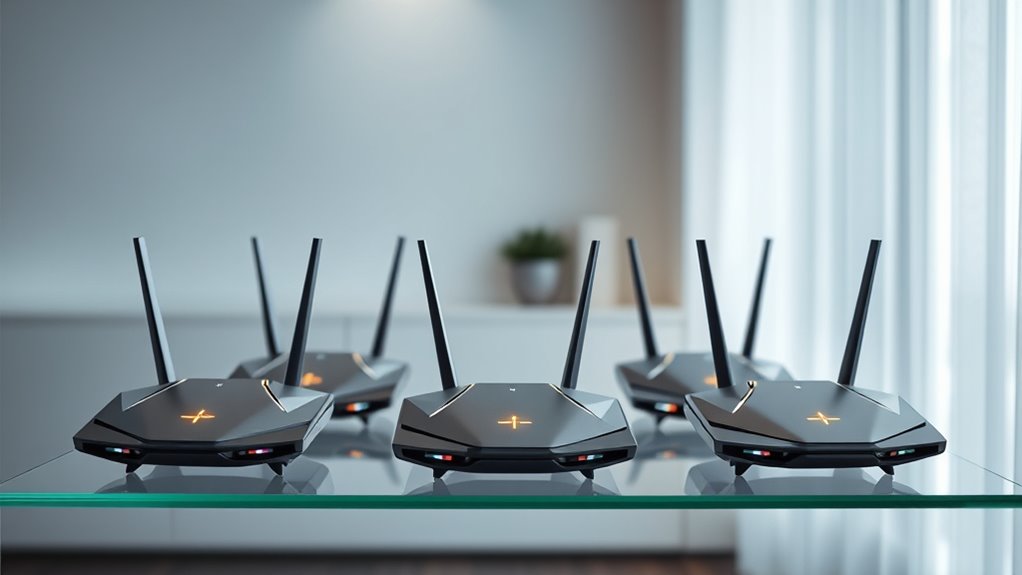If you’re looking for the best tri-band routers of 2025 for seamless Wi-Fi, I recommend options like the TP-Link AXE5400, ASUS RT-BE92U, and NETGEAR RAX70, which offer ultra-fast speeds, extensive coverage, and support for multiple devices. Many also feature mesh capabilities and advanced security to keep your network reliable and secure. Exploring these models will help you find the perfect fit for demanding homes and busy networks—keep going to explore more options.
Key Takeaways
- Top tri-band routers like TP-Link AXE5400, ASUS RT-BE92U, and NETGEAR RS300 deliver speeds up to 9.3 Gbps for demanding activities.
- Many models support advanced mesh technology and extensive coverage, ideal for large homes and multiple devices.
- Features such as WiFi 6E, WiFi 7, robust security, and easy app-based setup enhance seamless performance.
- High device capacity and intelligent management tools ensure stable connections for smart homes and high-bandwidth use.
- Consider compatibility, coverage area, and security features to choose the best tri-band router for 2025.
TP-Link AXE5400 Tri-Band WiFi 6E Router
If you’re looking for a router that can handle multiple devices with blazing-fast speeds, the TP-Link AXE5400 Tri-Band WiFi 6E Router is an excellent choice. It offers up to 5400 Mbps across three bands—6 GHz, 5 GHz, and 2.4 GHz—ensuring smooth streaming, gaming, and video calls. As TP-Link’s first WiFi 6E router, it introduces the new 6 GHz band for increased bandwidth and near-zero latency. Its powerful 1.7 GHz quad-core CPU and OFDMA technology support many devices simultaneously. Easy to set up via the Tether app, it also features robust security, whole-home coverage, and compatibility with major ISPs, making it ideal for demanding households.
Best For: households and users needing high-speed, reliable WiFi coverage for multiple devices, gaming, streaming, and smart home integration.
Pros:
- Supports combined WiFi speeds up to 5400 Mbps across three bands, ideal for demanding activities.
- Introduces the new 6 GHz band with WiFi 6E for increased bandwidth and near-zero latency.
- Easy setup with the TP-Link Tether app and seamless coverage with OneMesh support.
Cons:
- Some advanced features like parental controls, security, and QoS may require a subscription after a free trial.
- Larger homes may need additional extenders for full coverage in very distant areas.
- The high-performance hardware and advanced technology can be more expensive compared to basic routers.
TP-Link Tri-Band WiFi 7 Router Archer BE700
The TP-Link Archer BE700 stands out as an ideal choice for busy households or small businesses that demand ultra-fast, reliable Wi-Fi across multiple devices. With tri-band speeds up to 15Gbps, it leverages Wi-Fi 7 technology, including 6 GHz, 5 GHz, and 2.4 GHz bands, ensuring smooth 4K/8K streaming, gaming, and rapid downloads. Its Multi-Link Operation and channels up to 320 MHz minimize latency and maximize capacity. The router’s robust hardware features six antennas with Beamforming, multi-gig ports, and mesh compatibility, providing extensive coverage. Easy setup via the Tether app and strong security features make it a top-tier choice for seamless, high-performance home or small office networks.
Best For: households and small businesses requiring ultra-fast, reliable Wi-Fi with extensive coverage and multiple device support.
Pros:
- Tri-band speeds up to 15Gbps support high-bandwidth activities like 4K/8K streaming and gaming
- Six antennas with Beamforming technology enhance coverage and signal strength
- Easy setup via the Tether app and compatibility with mesh networks for seamless expansion
Cons:
- Higher price point compared to single or dual-band routers
- Advanced security features require a subscription for full access
- Size and weight may be less suitable for small or cluttered spaces
TP-Link AXE5400 Tri-Band WiFi 6E Router
The TP-Link AXE5400 Tri-Band WiFi 6E Router (Archer AXE75) stands out as an ideal choice for households that demand maximum speed and seamless connectivity across numerous devices. It offers up to 5400 Mbps combined across three bands, including the new 6 GHz band for faster speeds and near-zero latency. Equipped with a powerful 1.7 GHz Quad-Core CPU and 512 MB memory, it handles multiple device connections effortlessly. Its true tri-band setup, OFDMA technology, and support for OneMesh ensure excellent coverage and capacity. Easy to set up via the TP-Link Tether app, it’s perfect for gaming, streaming, and smart home integrations, making it a top contender for 2025.
Best For: households and gamers seeking maximum WiFi speeds, reliable coverage, and support for multiple devices with future-proof technology.
Pros:
- Supports combined speeds up to 5400 Mbps across tri-bands, including the new 6 GHz band for faster connectivity
- Equipped with a powerful 1.7 GHz Quad-Core CPU and 512 MB memory for seamless multitasking and performance
- Easy setup with TP-Link Tether app and supports OneMesh for whole-home coverage
Cons:
- Some features like parental controls, security services, and QoS require a subscription after a free trial
- Larger physical size may require more space for optimal placement
- Advanced settings and features might be complex for less tech-savvy users
TP-Link Tri-Band WiFi 7 Router (BE9300)
Looking for a router that can handle heavy streaming, gaming, and smart home devices simultaneously? The TP-Link Tri-Band WiFi 7 Router (BE9300) is built for that. It uses Wi-Fi 7 with speeds up to 9.2 Gbps across three bands—6 GHz, 5 GHz, and 2.4 GHz—thanks to Multi-Link Operation and 320 MHz channels. Its six internal antennas with Beamforming optimize stability and reduce interference. Plus, support for EasyMesh means you can expand coverage easily. Security features like WPA3 and TP-Link HomeShield protect your network, while the user-friendly app simplifies setup. This router offers a future-proof, reliable Wi-Fi experience for demanding households.
Best For: households requiring high-speed, reliable Wi-Fi coverage for streaming, gaming, and smart home devices simultaneously with easy network expansion.
Pros:
- Supports Wi-Fi 7 with speeds up to 9.2 Gbps across tri-bands for optimal performance
- EasyMesh compatibility allows seamless expansion of coverage with additional TP-Link devices
- Advanced security features like WPA3 and TP-Link HomeShield protect connected devices and user data
Cons:
- Initial setup and firmware updates may cause compatibility or stability issues if hardware isn’t fully supported
- Firmware updates can sometimes introduce bugs, affecting connection stability
- Requires devices supporting Wi-Fi 7 to fully utilize MLO and advanced features, which may not be compatible with older hardware
ASUS RT-BE92U Tri-Band WiFi 7 Router
If you’re seeking a high-performance router that can handle the demands of a smart home or a busy household, the ASUS RT-BE92U Tri-Band WiFi 7 Router stands out as an excellent choice. It delivers speeds up to 9700 Mbps using WiFi 7 technology, with features like 320MHz channels in the 6 GHz band and Multi-link Operation for stable, efficient data transfer. Its AI-boosted Smart AiMesh technology extends coverage, and wired speeds reach 20G. The router offers robust security with AiProtection Pro, IoT management, and parental controls. Easy to set up and reliable in large homes, it balances advanced features with user-friendly management, making it ideal for demanding networks.
Best For: users seeking a high-performance, reliable tri-band WiFi 7 router capable of handling large homes, smart home devices, and demanding household networks.
Pros:
- Delivers ultra-fast speeds up to 9700 Mbps with WiFi 7 technology and 6 GHz band support
- Extensive coverage and stability through AI-boosted Smart AiMesh and Multi-link Operation
- Robust security features with AiProtection Pro and IoT management for a safe connected home
Cons:
- Can run warm under continuous use, which may require additional cooling or placement considerations
- Firmware updates currently limit wired backhaul to secondary connections, complicating multi-router setups
- Marginal benefits over WiFi 6 for typical home users, with some latency issues inherent to WiFi technology
NETGEAR Nighthawk Tri-Band WiFi 7 Router (RS300)
For households with multiple smart devices, gaming consoles, and 4K streaming needs, the NETGEAR Nighthawk Tri-Band WiFi 7 Router (RS300) stands out as an ideal choice. It offers blazing-fast speeds up to 9.3Gbps, thanks to 320 MHz channels and the new 6 GHz band, ensuring smooth gaming and streaming. Its extensive coverage reaches up to 2,500 sq. ft., supporting up to 100 devices simultaneously with efficient load balancing. Security is robust with automatic updates and NETGEAR Armor, while the user-friendly app makes setup easy. Sleek and space-efficient, this router combines high performance, security, and ease of use for modern, connected homes.
Best For: households with multiple smart devices, gaming enthusiasts, and 4K streaming users seeking high-speed, reliable WiFi coverage.
Pros:
- Delivers ultra-fast speeds up to 9.3Gbps with WiFi 7 and 320 MHz channels
- Supports extensive coverage up to 2,500 sq. ft. and up to 100 devices simultaneously
- Features robust security with NETGEAR Armor and easy setup via user-friendly app
Cons:
- Higher cost compared to standard WiFi 6 routers
- May require compatible devices to fully utilize WiFi 7 capabilities
- Larger homes with more complex layouts might still experience dead spots without additional extenders
Linksys EA8100 Max-Stream AC2600 WiFi Router (Renewed)
The Linksys EA8100 Max-Stream AC2600 MU-MIMO WiFi Router is an excellent choice for households or small offices that need reliable, high-speed connectivity across multiple devices. Its dual-band AC2600 design supports speeds up to 1733 Mbps on 5GHz and 800 Mbps on 2.4GHz, perfect for streaming and gaming. Equipped with an 880MHz dual-core processor and four adjustable external antennas, it ensures strong coverage and signal stability. With four gigabit LAN ports, a USB 3.0 port, and a USB 2.0 port, it offers versatile connectivity options. As a renewed device, it provides excellent value while delivering robust performance for demanding network needs.
Best For: households or small offices seeking reliable, high-speed WiFi coverage with multiple device support and versatile connectivity options.
Pros:
- Supports high wireless speeds up to 1733 Mbps on 5GHz and 800 Mbps on 2.4GHz, ideal for streaming and gaming.
- Equipped with MU-MIMO technology and adjustable external antennas for enhanced coverage and signal stability.
- Offers multiple ports including four gigabit LAN, USB 3.0, and USB 2.0 for flexible device connections.
Cons:
- Being a renewed product, it may have limited warranty and potential wear from previous use.
- Larger dimensions (10.06 x 7.33 x 1.99 inches) may require more space and proper placement.
- Limited to StarHub exclusivity, which might restrict availability in certain regions or stores.
NETGEAR Nighthawk Tri-Band WiFi 7 Router (RS300)
The NETGEAR Nighthawk Tri-Band WiFi 7 Router (RS300) stands out as an ideal choice for households demanding high-speed, reliable internet across numerous devices. It delivers speeds up to 9.3Gbps, leveraging 320 MHz channels and the ultra-fast 6 GHz band for smooth gaming, streaming, and video calls. Covering up to 2,500 sq. ft., it handles up to 100 devices simultaneously with efficient tri-band distribution. Equipped with multiple LAN ports and advanced security features like NETGEAR Armor, it keeps your network safe. Easy to set up via the mobile app, this router combines sleek design, high performance, and future-proof WiFi 7 support for extensive home coverage.
Best For: households and tech enthusiasts seeking ultra-fast, reliable WiFi coverage for multiple devices, gaming, streaming, and smart home integration.
Pros:
- Delivers blazing-fast speeds up to 9.3Gbps with WiFi 7 technology.
- Supports up to 100 devices simultaneously with extensive coverage of 2,500 sq. ft.
- Advanced security features including NETGEAR Armor and easy setup via the mobile app.
Cons:
- Higher price point compared to basic routers, which may not suit all budgets.
- Requires compatible WiFi 7 devices to fully utilize the speed benefits.
- The sleek design, while space-efficient, may have a smaller antenna array that could impact range in very large or complex homes.
TP-Link Deco AXE5400 Tri-Band WiFi 6E Mesh System
If you’re looking to eliminate dead zones and support a large number of devices seamlessly, the TP-Link Deco AXE5400 Tri-Band WiFi 6E Mesh System is an excellent choice. It covers up to 7,200 sq. ft. and replaces traditional routers and extenders, ensuring all-encompassing coverage. With a new 6 GHz band, it reduces interference and supports WiFi 6E devices directly, delivering speeds up to 5,400 Mbps across three bands. Supporting up to 200 devices simultaneously, it enhances network efficiency and reduces congestion. The system features AI-driven mesh for smart, adaptive connectivity, easy setup via the Deco app, and compatibility with Alexa for voice control.
Best For: households or small offices seeking seamless, high-speed WiFi coverage over large areas with support for numerous devices.
Pros:
- Covers up to 7,200 sq. ft. and supports up to 200 devices for comprehensive connectivity.
- Features WiFi 6E tri-band technology with speeds up to 5,400 Mbps, reducing interference and congestion.
- Easy setup and management via the Deco app, with voice control compatibility with Alexa.
Cons:
- Higher cost compared to traditional WiFi routers and extenders.
- Requires compatible devices to fully utilize the WiFi 6E features.
- Potential overkill for small spaces with minimal device needs.
NETGEAR Nighthawk WiFi 7 Router (RS280S)
Looking for a router that can handle multiple high-demand devices simultaneously? The NETGEAR Nighthawk WiFi 7 Router (RS280S) is a powerhouse, delivering speeds up to 9.2 Gbps with 320 MHz channels, making it over twice as fast as WiFi 6. It supports up to 100 devices at once, ideal for busy homes. Its tri-band WiFi includes an ultra-fast 6 GHz band, offering coverage up to 2,500 sq. ft., perfect for streaming, gaming, and smart devices. With multi-gig Ethernet ports and a sleek design, it combines speed, reliability, and extensive coverage—making it a top choice for seamless, high-performance home networks.
Best For: households with multiple high-demand devices seeking ultra-fast speeds, extensive coverage, and reliable wired and wireless connections.
Pros:
- Supports speeds up to 9.2 Gbps with advanced WiFi 7 technology for top-tier performance
- Capable of handling up to 100 devices simultaneously, ideal for busy smart homes
- Offers comprehensive security features including NETGEAR Armor and automatic firmware updates
Cons:
- Higher price point compared to standard routers with similar features
- Some users report minor bugs and connectivity issues that may require firmware updates
- May be overkill for smaller homes or less demanding internet needs
ASUS RT-AXE7800 Tri-band WiFi 6E Router
For anyone seeking top-tier WiFi performance in demanding environments, the ASUS RT-AXE7800 Tri-band WiFi 6E Router stands out as an excellent choice. Supporting WiFi 6E with a dedicated 6 GHz band, it delivers speeds up to 7800 Mbps, perfect for gaming, streaming, and complex setups. It offers higher capacity, stable connections, and better coverage, even in challenging environments. With features like AiMesh for whole-home coverage, multiple Gigabit ports, and 2.5G Ethernet, it’s future-proof. Easy to set up, reliable, and praised for strong range and low latency, it’s a top option for high-performance home networks.
Best For: high-demand households and gamers seeking ultra-fast, reliable WiFi with extensive coverage and advanced network management features.
Pros:
- Supports WiFi 6E with speeds up to 7800 Mbps for demanding applications like gaming and streaming
- Offers seamless whole-home coverage with AiMesh and multiple Gigabit Ethernet ports including 2.5G support
- Easy setup, stable performance, and strong WiFi range with low latency, suitable for complex network environments
Cons:
- Limited WiFi 6E range; performance may drop beyond 15 feet or through walls
- Some users report issues with 2.5 GbE port limitations over certain modems
- Multi-WAN failover can temporarily expose VPN traffic, affecting privacy in specific configurations
TP-Link Deco AXE5400 Tri-Band WiFi 6E Mesh System (Deco XE75 Pro) 2-Pack
The TP-Link Deco AXE5400 Tri-Band WiFi 6E Mesh System (Deco XE75 Pro) 2-Pack is an ideal choice for households and small businesses that demand fast, stable internet across large spaces. It covers up to 5,500 sq.ft. and uses WiFi 6E with a dedicated 6 GHz band to reduce interference and dead zones. With speeds up to 5,400 Mbps, including a 2.5 Gbps port for multi-gigabit plans, it supports up to 200 devices. Its AI-driven mesh technology ensures seamless, adaptive connectivity, while easy setup and security features make managing your network simple and secure.
Best For: households and small businesses seeking fast, reliable, and extensive WiFi coverage across large areas with minimal interference.
Pros:
- Provides seamless tri-band WiFi 6E coverage up to 5,500 sq.ft., reducing dead zones.
- Supports multi-gigabit internet plans with a 2.5 Gbps port and up to 200 connected devices.
- Features AI-driven mesh technology for adaptive, stable, and easy-to-manage networks.
Cons:
- Higher price point compared to traditional routers, which may be a consideration for budget-conscious users.
- Requires app management, which might be less ideal for those preferring traditional router interfaces.
- Limited to two units in the pack, which may not be sufficient for extremely large or complex spaces without additional units.
Linksys Mesh WiFi 6 Router (Renewed)
If you have a large home or multiple devices streaming, gaming, or working simultaneously, the Linksys Mesh WiFi 6 Router (Renewed) offers reliable coverage and high speeds to meet those demands. Covering 3,000 sq. ft. and supporting over 40 devices, it delivers speeds up to 6.0Gbps. Its mesh technology guarantees seamless connectivity across your space, even through walls or multiple floors. While setup can be a bit complex, once configured, users report stable, fast connections with minimal lag. Many appreciate its value, durability, and ability to expand mesh coverage. Despite some app and setup hurdles, it remains a solid choice for large households seeking robust Wi-Fi performance.
Best For: households with large square footage needing reliable, high-speed Wi-Fi coverage for multiple devices simultaneously.
Pros:
- Supports mesh expansion for seamless coverage across large or multi-floor homes
- Delivers high speeds up to 6.0Gbps, ideal for gaming, streaming, and heavy usage
- Reliable, stable connections with effective performance even through walls and obstacles
Cons:
- Setup can be complex and may require troubleshooting or multiple attempts
- App dependency and limited advanced configuration options can frustrate tech-savvy users
- Lack of detailed support documentation and manual for refurbished units
Linksys Mesh WiFi Hydra Pro 6E Router
The Linksys Mesh WiFi Hydra Pro 6E Router stands out as an excellent choice for those seeking a high-speed, reliable network that can handle multiple devices simultaneously. It offers speeds up to 6.6Gbps with a dedicated 6 GHz band, ensuring interference-free performance. Covering up to 2,700 sq. ft., it supports over 55 devices, making it perfect for busy homes with demanding needs like streaming, gaming, and video calls. Setup is simple via the app or web, though the web interface is limited. Despite some range concerns and a short 90-day warranty, its affordability as a renewed device makes it a solid option for high-speed, seamless connectivity.
Best For: households requiring high-speed, reliable WiFi with easy setup and support for multiple devices, especially for streaming, gaming, and video conferencing.
Pros:
- Supports ultra-fast speeds up to 6.6Gbps with a dedicated 6 GHz band for interference-free performance
- Extends coverage up to 2,700 sq. ft. and supports over 55 devices simultaneously
- Easy setup via app or web interface, making installation straightforward
Cons:
- Limited web interface with few advanced configuration options like VLAN support and channel management
- Range may be less than previous models, with some users experiencing reduced coverage
- Short 90-day warranty compared to more extended coverage offered by competitors
NETGEAR Nighthawk WiFi 6 Router (RAX70)
For anyone seeking ultra-fast WiFi with extensive device support, the NETGEAR Nighthawk WiFi 6 Router (RAX70) stands out as an ideal choice. It delivers AX6600 tri-band speeds up to 6.6 Gbps, covering 2,500 sq. ft. and supporting up to 40 devices simultaneously. Powered by a quad-core 1.5GHz processor, it’s perfect for streaming, gaming, and video calls. Compatible with ISPs up to 2Gbps, it replaces your existing router with ease. Features include four Gigabit Ethernet ports, a USB 3.0 port, and support for high-speed 160MHz channels. Setup is simple via the Nighthawk app, making high-capacity WiFi accessible for most homes.
Best For: households and individuals seeking ultra-fast, reliable WiFi with extensive device support for streaming, gaming, and smart home connectivity.
Pros:
- Supports AX6600 tri-band speeds up to 6.6 Gbps for high-performance applications
- Covers up to 2,500 sq. ft. and supports up to 40 devices simultaneously
- Easy setup via the Nighthawk app with user-friendly management features
Cons:
- Limited number of Ethernet ports (four) may require additional switches for many wired devices
- Coverage may be insufficient in very large or multi-story homes without additional access points or mesh systems
- Some advanced features like port aggregation and antenna placement lack detailed documentation
Factors to Consider When Choosing Tri‑Band Routers

When choosing a tri-band router, I focus on the network speed capabilities and coverage to guarantee my entire home stays connected smoothly. I also consider device compatibility and security features to keep everything secure and running efficiently. Finally, I look at how easy it is to set up and manage the router for hassle-free use.
Network Speed Capabilities
Choosing a tri-band router with the right network speed capabilities means understanding how much data it can handle simultaneously. These routers can deliver combined speeds from around 5,400 Mbps up to over 15,000 Mbps, depending on the model and Wi-Fi standards like Wi-Fi 6 or Wi-Fi 7. Each band’s maximum throughput varies—newer standards, such as Wi-Fi 7, can exceed 11 Gbps per band, greatly boosting overall performance. To fully utilize high-speed internet plans, look for routers with multi-gig ports and wide channels up to 320 MHz. Advanced modulation techniques like 1024-QAM also improve transfer rates. Remember, your network speed depends not just on the router but also on device compatibility, network congestion, and your ISP’s connection quality.
Coverage and Range
Ever wondered how to get the most dependable Wi-Fi coverage throughout your home? Tri-band routers are designed to maximize coverage by using a dedicated 6 GHz backhaul, which helps reduce dead zones. The number and placement of antennas play a vital role; more antennas typically mean wider signal reach. Higher speeds, like over 9 Gbps, can also improve range stability by maintaining strong signals over longer distances. Beamforming technology further enhances coverage by focusing signals directly toward connected devices, boosting signal strength and extending range. However, environmental factors such as walls, furniture, and interference from other electronics can weaken signals. Proper placement and signal optimization are necessary to guarantee your tri-band router delivers consistent, dependable coverage across your entire home.
Device Compatibility
To get the most out of your tri-band router, making sure it’s compatible with your devices and existing network setup is essential. First, check that the router supports Wi-Fi standards like Wi-Fi 6 or Wi-Fi 7, guaranteeing your devices can leverage the latest speeds and efficiency. Confirm that your devices operate on the 2.4 GHz, 5 GHz, and 6 GHz bands (if supported), so you can fully utilize the tri-band capabilities. It’s also important to verify that your modem and network infrastructure work with the router’s Ethernet ports and multi-gigabit features for maximum performance. Finally, ensure the router’s security protocols, such as WPA3, match your security needs, and that management apps support your operating systems for easy setup and control.
Security Features
When evaluating tri-band routers, security features play a vital role in protecting your network and connected devices. Many advanced models include WPA3 encryption, which offers stronger protection against hacking attempts and eavesdropping. Built-in security tools like VPN support, firewalls, and threat detection help safeguard your data and prevent malware infiltration. Keep in mind, some features might require a subscription or firmware updates to access the latest security enhancements. Robust security protocols are essential for preventing unauthorized access, data breaches, and device compromise across your network. Parental controls and device isolation are also common, allowing you to manage access and create safer online environments for everyone. Prioritizing these security features ensures your network remains resilient against evolving threats.
Setup and Management
Choosing a tri-band router with easy setup and management features can save you time and frustration. I look for routers that offer mobile apps or web interfaces that guide me step-by-step through installation, making setup quick and straightforward. Multi-device management options, like guest networks and QoS, give me control over my network, prioritizing devices or limiting access when needed. Firmware updates are essential for security and performance; I prefer routers that support automatic or simple manual updates. Compatibility with standards like EasyMesh or multi-WAN ensures my network can expand smoothly without compatibility issues. Clear, accessible management tools, such as intuitive apps, detailed dashboards, and remote controls, help me troubleshoot and optimize my Wi-Fi without hassle. These features make ongoing network control simple and efficient.
Future-Proof Technologies
Staying ahead with future-proof tri-band routers means looking for the latest technologies that can handle tomorrow’s demands. Wi-Fi 7’s Multi-Link Operation (MLO) allows devices to use multiple bands simultaneously, boosting throughput and reducing latency, which is essential for high-demand tasks. Wi-Fi 6E introduces the 6 GHz band, offering more bandwidth and less interference, ensuring your network remains fast and reliable as more devices connect. Multi-Gigabit Ethernet ports, like 2.5 Gbps and 10 Gbps, prepare your wired setup for future high-speed needs and expanding networks. Advanced security protocols such as WPA3 and integrated VPN support help protect your data against evolving threats. Ultimately, mesh compatibility and easy upgrades ensure your router remains scalable and compatible with upcoming Wi-Fi standards, securing your investment long-term.
Price and Value
Finding the right tri-band router involves balancing performance features with your budget to get the best value. More expensive models often deliver faster speeds, wider coverage, and advanced security, but they may not be necessary for smaller or less demanding homes. Prices can range from under $300 for WiFi 6E options to over $900 for premium WiFi 7 models. When evaluating cost, consider long-term value, such as future-proof features like WiFi 7 support or mesh compatibility, which can extend your router’s usefulness. Comparing features relative to price helps identify the best deal, especially if you plan to add subscription-based security services or hardware upgrades later. Ultimately, finding a router that meets your needs without overspending guarantees you get good performance at a fair price.
Design and Aesthetics
When selecting a tri-band router, the design and aesthetics play a crucial role in ensuring it complements your home environment while delivering peak performance. Most models feature a sleek, modern look with multiple antennas to enhance signal coverage. The physical size varies, with some routers being compact and others larger to accommodate internal components and cooling needs. Many have minimalistic exteriors with subtle LED indicators that blend seamlessly into any decor. External antennas are often adjustable or detachable, allowing you to position them for ideal signal focus. The build quality and choice of materials also impact durability and how well the router integrates into your space. Ultimately, choosing a router that balances style and function helps create a cohesive, tech-savvy home environment without sacrificing performance.
Frequently Asked Questions
How Do Tri-Band Routers Improve Overall Wi-Fi Network Capacity?
Tri-band routers boost Wi-Fi network capacity by offering three separate frequency bands—usually one 2.4 GHz and two 5 GHz. I’ve found this setup helps distribute devices more evenly, reducing congestion and speeding up connections. Instead of competing for bandwidth on a single band, devices can connect to less crowded channels. This means smoother streaming, faster downloads, and fewer interruptions, making my Wi-Fi experience much more reliable.
Are Tri-Band Routers Suitable for Smart Home Integrations?
Tri-band routers are definitely suitable for smart home integrations. I’ve found that their extra band helps handle multiple devices without lag, which is perfect for smart gadgets like lights, thermostats, and security cameras. The additional band reduces congestion, ensuring smooth operation for all your smart devices. So, if you’re building a connected home, a tri-band router can really boost your network’s performance and reliability.
What Is the Typical Lifespan of a Tri-Band Router?
They say “time flies,” and that’s true for tech too. Typically, a tri-band router lasts about 3 to 5 years, depending on usage and updates. I’ve seen them become outdated faster if newer Wi-Fi standards emerge or if they struggle with increasing device demands. Regular firmware updates can extend their lifespan, but eventually, upgrading is the best way to keep up with evolving technology and guarantee peak performance.
How Do Firmware Updates Enhance Tri-Band Router Performance?
Firmware updates are essential for boosting my tri-band router’s performance. They fix bugs, patch security vulnerabilities, and improve stability, ensuring my network runs smoothly. Plus, updates often add new features or enhance existing ones, like better device management or faster speeds. I make it a habit to install updates promptly, which keeps my Wi-Fi reliable, secure, and capable of handling the latest devices and online demands.
Can Tri-Band Routers Prioritize Bandwidth for Specific Devices?
Did you know that over 60% of home Wi-Fi users want better control over their network? Tri-band routers can prioritize bandwidth for specific devices, ensuring your gaming console or streaming device gets the speed it needs. I’ve seen this feature make a huge difference in performance. It’s like giving your favorite devices a VIP pass, so they run smoothly without being slowed down by other gadgets.
Conclusion
Choosing the right tri-band router can truly elevate your Wi-Fi experience. I believe that investing in a high-quality, future-proof router isn’t just about faster speeds but ensuring seamless connectivity across all devices. It’s like the theory that better infrastructure supports more robust systems—so don’t settle for less. With these top options, you’ll likely find a router that not only meets but exceeds your needs, proving that smart choices today prevent Wi-Fi headaches tomorrow.






















